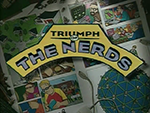 Beta software is pre-release software, sometimes almost experimental (alpha) software. Beta testing was as cool as it got in the mid ’90s if you were into computers. As a beta tester, you were getting to play around with, and help develop, software that potentially millions of people would use. The only way to get beta software was to either be in an official beta program or know somebody. That was because of two details I can’t stress enough: the Internet wasn’t popular yet, and those of us that had Internet access almost always had a slow dial-up connection. Getting beta software meant relying on big software companies to ship out a CD-R to you every week via UPS. When I was fourteen, I found the email address for Microsoft’s Senior V.P. for Developer Tools and emailed him requesting to be on some beta programs. He emailed me back and said he’d see what he could do. I can’t prove he had anything to do with it, but I ended up on at least three good betas: the Windows 95 Preview Program, Microsoft DirectX 1.0, and Microsoft FrontPage 1.0. As a teenager, routinely getting UPS envelopes with CD-R’s of unreleased software, and being asked for my feedback, made me feel important.
Beta software is pre-release software, sometimes almost experimental (alpha) software. Beta testing was as cool as it got in the mid ’90s if you were into computers. As a beta tester, you were getting to play around with, and help develop, software that potentially millions of people would use. The only way to get beta software was to either be in an official beta program or know somebody. That was because of two details I can’t stress enough: the Internet wasn’t popular yet, and those of us that had Internet access almost always had a slow dial-up connection. Getting beta software meant relying on big software companies to ship out a CD-R to you every week via UPS. When I was fourteen, I found the email address for Microsoft’s Senior V.P. for Developer Tools and emailed him requesting to be on some beta programs. He emailed me back and said he’d see what he could do. I can’t prove he had anything to do with it, but I ended up on at least three good betas: the Windows 95 Preview Program, Microsoft DirectX 1.0, and Microsoft FrontPage 1.0. As a teenager, routinely getting UPS envelopes with CD-R’s of unreleased software, and being asked for my feedback, made me feel important.
Microsoft Windows 95 Preview Program
Microsoft Chicago was the codename for Windows 95 before it was Windows 95. InfoWorld and other industry trade magazines were the only place where most people got to see the occasional rare screenshot of Microsoft’s big new upgrade to Windows 3.1. I knew of a few people whose employers were in the official enterprise beta program for Microsoft Chicago. They let me try out the beta releases when they didn’t have time to install/test it themselves. That was exciting because Microsoft Chicago, later renamed in beta as Windows 95, was unlike any previous version of Windows. Every beta release of Chicago/Windows95 had big changes and new features. I got my own official beta release CD of Windows 95 as part of the Microsoft Windows 95 Preview Program. When I attended a day-long Microsoft TechNet event beamed via satellite to a local movie theater, I also got a newer beta release build.
Microsoft FrontPage 1.0
The Browser Wars began right after the release of Windows 95. Competing with Netscape for the Internet was Microsoft’s top priority. Bill Gates had sent out his infamous Internet Tidal Wave memo the previous May and subsequently reorganized Microsoft around Internet development. FrontPage was Microsoft’s web page creation software. FrontPage was initially a product made by a company called Vermeer Technologies, which Microsoft acquired. I remember the first web page I ever created, late one night when I finally had the time to install it, to test FrontPage and its feature to automatically upload to GeoCities. The webpage was a fanpage dedicated to Pimpbot 5000, a character on Late Night with Conan O’Brien.
Microsoft DirectX 1.0
DirectX is several technologies developed by Microsoft, currently on version 12 and originally for Windows 95, to create an abstraction layer between hardware and software. Instead of software developers writing software specifically for each piece of hardware (like a specific videocard or soundcard), the developer could use Microsoft’s Software Development Kit (SDK) and take advantage of standard Application Programming Interfaces (API’s) that worked on multiple brands/configurations of hardware. For example, DirectPlay made it possible to develop network games, DirectSound to develop sound effects for every soundcard, and Direct3D to develop 3D games that worked on every videocard. I never really got into programming anything that required working with hardware, but it was always fun to try out the DirectX technology demo software that came with the beta releases and that could sometimes be found on the Internet. Microsoft showed off the initial release of DirectX for Windows 95 at a Microsoft-hosted Deathmatch tournament, with Bill Gates putting himself into a game of DooM.
Nerd Badge of Honor
Being on a good beta program was at one time a nerd badge of honor. Many of my evenings as a teenager were spent in my bedroom beta testing software. Many weekends were devoted to going to software stores and attending user groups to discuss the latest beta releases. And when that beta software was finally released as a commercial product, the beta testers always knew the most about it and could do the best job making money to write about, consult on, and support the product. Beta testing furthered the whole software ecosystem. Today everybody is effectively a beta tester because everybody is always online. Updating software is as easy as uploading the new releases to Google Play and Apple App Store. For those of us that enjoyed trying new technology back in the day, beta testing brings back some good memories.
 Triumph of the Nerds: The Personal Computer
Triumph of the Nerds: The Personal Computer
 Prizeo Brings Together Celebrities And Charities To Increase Awareness And Raise Money
Prizeo Brings Together Celebrities And Charities To Increase Awareness And Raise Money
 Venture Deals Explains Modern Venture Capital
Venture Deals Explains Modern Venture Capital
 Five Years of Y Combinator Universe
Five Years of Y Combinator Universe




